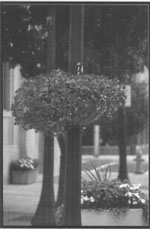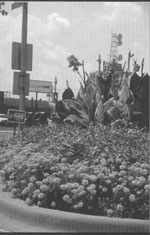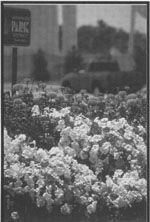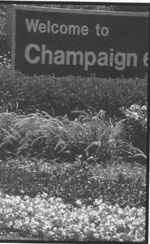


SPECIAL FOCUS
Champaign
Oftentimes a flower bed is the first made

|
|
|
Ask any Champaign-area resident to name the most distinctive aspect of the Champaign Park District and chances are the first thing mentioned is the flowers. The district's Flower Island program has transformed Champaign into the "city of flowers."
"We get more comments on the Flower Islands than anything else," says Champaign Park District general manager Bob Toalson.
But then, 172,000 marigolds, daisies, black-eye susan, daffodils, tulips and others add a lot of color and positive energy to cement-framed curbs, street medians and city sidewalks.
A Seed Is Planted
In 1984 Champaign business leader George Shapland approached Champaign Park District officials with the idea of making the city a "community of flowers." His concept of district staff designing, planting, and maintaining flower beds on business property was met with a resounding no.
How could officials justify utilizing the tax supported district resources of staff and equipment to complete such a project on private property?
Determined to make it work, Shapland enlisted the help of an additional business leader, Tom Harrington, Jr. They felt the Champaign Park District staff was the most knowledgeable and talented group to make the idea work. Together they continued, year after year, to approach district officials with the idea. After denying the request for several years and wanting to cooperate with these two influential community leaders, district officials produced a solution.
A Partnership Takes Root
The solution was simple. The district would create a partnership with area businesses, which would contribute funds to cover the cost of their flower bed and the sponsorship of an equivalent size bed to be placed on public property. Hence, aesthetically enhancing the community twice.
Public beds would be located in parks, at schools and libraries, and on easements. The business community accepted the solution with open arms and the Flower Island program began in 1988. That year district staff planned, planted, maintained, and cleaned six Flower Island sites, with roughly $8,000 in business contributions. Not wanting to overburde staff by taking on more flower beds than necessary, district officials and staff chose to initiate the program with caution and begin with only a handful of islands.
Word about Flower Islands began to spread and, 11 years later, the program has grown to 181 Flower Islands and more than $95,000 in business contributions. The district also supports approximately 100 additional beds.
So, You Want To Buy an Island?
Any Champaign business is eligible to apply for a Flower Island on their premises. New sites are selected based on four criteria:
• Visibility
Islands are developed in high-traffic areas so
34 / Illinois Parks and Recreation
in Bloom
to recover a blighted neighborhood

|
|
|
BY AMANDA ROESCH
residents may enjoy them while walking, riding, or driving.
• Location
Islands are evenly distributed throughout the community.
• Size
The minimum size is 200 square feet, unless special conditions exist.
• Duplication
Care is taken to avoid duplication of current and future beautification efforts.
The district also established other necessary guidelines for the program:
• The Flower Island must be compatible with the surrounding architecture.
• Flower Island site development must either be performed by the district with expenses reimbursed by the property owner, or performed by a private contractor engaged by the property owner under the supervision of the district.
• Planting and maintenance expenses are charged to the property owner. (Current Flower Island sites cost $6.50 per square foot.)
• All planning, site selection, development, construction, and maintenance are the responsibility of the district.
• Water service is required for all sites. If this is not available, a new service is installed as part of the initial cost.
• Any discontinued site is returned to its original condition by the district. The property owner will reimburse the district for additional expenses incurred during this process.
Crews on Flower Detail
The Flower Islands are the most noticeable aspect of the Champaign Park District. Thus these crews are the most visible. The district employs nine full-time landscape staff, five of whom work primarily with the Flower Island program. An additional 16 seasonal workers are also assigned to flower detail.
Rising to the challenge of keeping the island layouts fresh, landscape staff first consider a color change from the previous year. Additional consideration is given to the height of the flowers and the perspective of those passing by the bed.
"We design in November and December," full- time landscaper Greg Sancken says. "We try to rotate things around from one year to the next. We look for different colors and schemes and try to remember what's down the street."
"You get to be creative and get your hands dirty, too," says landscaper Neil Sudduth. "It's rewarding."
Bids for the flowers are let during January, and the orders are placed in February. Flower Island signs are installed in March. Each site is identified
September/October 1999 / 35
SPECIAL FOCUS
Champaign's Flower Island program has encouraged and inspired private landscape beautification efforts.
with a small green sign bearing the Flower Island logo or park district logo.
The flower storage racks become a sea of color as the flowers begin arriving in late-April. The shipments don't stop until mid-June.
Flower Island crew members spend the months of May and June installing the nearly 172,000 flowers needed to support the beds. The planting crews carry with them a binder containing sketches illustrating the planned locations and types of plant material for each Flower Island.
Some of the Flower Islands require creative thinking because of their unconventional location. In addition to the traditional beds, flowers can be found planted in whiskey barrels, a rowboat, a wagon, and basket containers designed to snap onto utility poles.
The islands are watered daily and, although often planted thick enough to stunt their growth, weeded as necessary.
"I learn a little bit every day," says Ben Carlson, about his tasks as a seasonal Flower Island crew member.
As the vibrant island colors begin to fade in the fall, the flowers are replaced by various bulbs, such as tulip and daffodil. These bulbs provide a welcome burst of color each spring. Some of the beds in high visibility locations are planted a second time in the fall to provide fall color.
Flower Power
The program has encouraged and inspired private landscape beautification efforts. Oftentimes a flower bed is the first effort made to recover a blighted neighborhood. Within these areas, the Champaign Park District and city of Champaign staff have begun to work together to improve neighborhood pride.
One such example of this is a bed placed in front of a recycling plant. After witnessing the impact of the Flower Island, the property owner supplemented the area with trees and a landscaping fence.
Flower Islands greet Champaign visitors and residents with their welcoming, vibrant colors. Champaign truly has become the city of flowers.
AMANDA ROESCH
Is the promotions coordinator for the Champaign Park District. Photographs of the Champaign Park District Flower Islands pages 34 and 35 were shot by Amanda Roesch.
|
Champaign Is Recognized by "Nations In Bloom"
The Champaign Park District was invited by the Nations in Bloom Committee to represent the United States in the inaugural Nations In Bloom contest held September 15—17, 1996, in Bedford, England. District staff Robert Toalson, Jim Spencer, and Greg Sancken attended and presented, among other things, the district's Flower Island program. The Nations in Bloom contest encourages enhanced public awareness of environmental management as a means of improving the quality of life for all citizens and to encourage others to achieve high standards. The competition judging includes the appropriate planting and greening of city landscape, efforts to encourage the use of environmentally sensitive practices, and the contribution that open urban spaces make to the quality of life and the beautification of the community. The district received a "Highly Commended" certificate in the category of 25,000 to 125,000 population. St. Edmunsdburg, United Kingdom, also received a certificate. The winning community in this category was Brantford, Canada. In addition to the competition, district staff were on-the-lookout for innovative ideas. A community garden contest is one such idea staff transplanted to the Champaign area. The Beauty Contest Goes Local As an extension of the district's Flower Island program and a part of a continuing effort to beautify the community, Toalson approached local garden store owner Jeff Wandell about sponsoring this a contest. Thus, the "C Us in Bloom" garden contest was initiated. The contest recognizes the effort devoted to creating beautiful home and business gardens visible to those passing by either on the sidewalk or the street. In addition, the contest acknowledges the efforts of those members of the community which improve upon the beautification of the city. In its first year, the contest was held solely for the residents of Champaign, but has blossomed over the past two years to include the sister cities of Urbana and Savoy. The entries have sprouted from a meager 75 to a healthy 250 in 1999. — by Amanda Roesch. For information about Nations in Bloom, contact Nations in Bloom,The Grotto, Lower Bosildon, Reading, Berkshire, England RG8 ONE; telephone, +44 {0} 1491 874800; fax, +44 {0} 149] 87480]; e-mail, davGmeli@ilam.co, uk; Web site, www.ifpra.org |
36 / Illinois Parks and Recreation